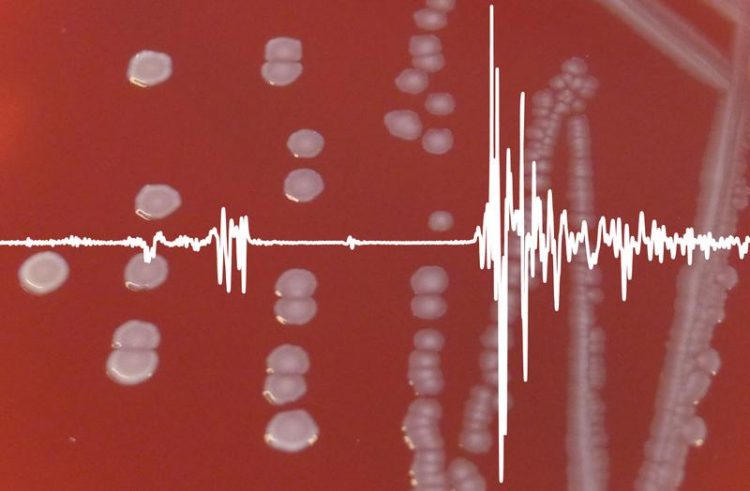Bacterial Memories – Host influences bacterial metabolism

Bacteria on a plate and the respective FTIR spectrum in front. Photo: Tom Grunert/Vetmeduni Vienna
Bacteria are known to specifically adapt to host environments. Understanding these adaptation mechanisms is crucial for the development of effective therapeutics.
Mouse lineage influences bacterial metabolism
Monika Ehling-Schulz’s group from the Institute of Microbiology, together with Mathias Müller’s group at the Institute of Animal Breeding and Genetics studied the influence of host organisms on bacterial metabolism. The researchers infected three different lineages of mice with the bacteria Listeria monocytogenes. The mouse strains showed significant differences in their response to the infection and in the severity of the clinical symptoms.
The researchers isolated the bacteria days after infection and analysed them for changes in their metabolism. They used a specific infrared spectroscopy method (FTIR) to monitor metabolic changes. The chemometric analysis of the bacterial metabolic fingerprints revealed host genotype specific imprints and adaptations of the bacterial pathogen.
“Our findings may have implications on how to treat infectious diseases in general. Every patient is different and so are their bacteria”, first author Tom Grunert states.
Memory effect in bacteria
After isolation from the mice, all bacteria were cultured under laboratory conditions. After prolonged cultivation under laboratory conditions all three bacterial batches switched back to the same metabolic fingerprint. “Based on our results it can be assumed that bacteria have some sort of memory. It takes some time under host-free laboratory conditions for this ‘memory effect’ to vanish,” explains the head of the Institute, Monika Ehling-Schulz.
Vibrating molecules decipher bacterial metabolism
The researchers employed a technique known as Fourier-transform infrared (FTIR) spectroscopy to monitor the metabolism in the bacteria. An infrared beam directed through the bacteria causes molecules such as proteins, polysaccharides and fatty acids to vibrate. The molecules variably allow more or less light to pass. The different molecular composition in the bacteria yields different spectral data providing information about the molecules inside.
“This method is used especially in microbiological diagnostics to identify bacteria. But we refined the method to decipher and monitor differences in the metabolic fingerprint of the same bacteria,” says Grunert.
In the future, the researchers want to extend the concept to other species of bacteria and further study the impact of host organisms on pathogens. In a next step, the team plans to find out what exactly it is, that leads to metabolic changes in bacteria.
Service:
The article “Deciphering Host Genotype-Specific Impacts on the Metabolic Fingerprint of Listeria monocytogenes by FTIR Spectroscopy” by Tom Grunert, Avril Monahan, Caroline Lassnig, Claus Vogl, Mathias Müller and Monika Ehling-Schulz was published in the journal PLOS One. http://journals.plos.org/plosone/article?id=10.1371/journal.pone.0115959
About the University of Veterinary Medicine, Vienna
The University of Veterinary Medicine, Vienna in Austria is one of the leading academic and research institutions in the field of Veterinary Sciences in Europe. About 1,300 employees and 2,300 students work on the campus in the north of Vienna which also houses five university clinics and various research sites. Outside of Vienna the university operates Teaching and Research Farms. http://www.vetmeduni.ac.at
Scientific Contact:
Prof. Monika Ehling-Schulz
Unit of functional Microbiology
University of Veterinary Medicine Vienna (Vetmeduni Vienna)
T +43 1 25077-2460
monika.ehling-schulz@vetmeduni.ac.at
Released by:
Susanna Kautschitsch
Science Communication / Public Relations
University of Veterinary Medicine Vienna (Vetmeduni Vienna)
T +43 1 25077-1153
susanna.kautschitsch@vetmeduni.ac.at
http://www.vetmeduni.ac.at/en/infoservice/presseinformation/press-releases-2015/…
Media Contact
All latest news from the category: Life Sciences and Chemistry
Articles and reports from the Life Sciences and chemistry area deal with applied and basic research into modern biology, chemistry and human medicine.
Valuable information can be found on a range of life sciences fields including bacteriology, biochemistry, bionics, bioinformatics, biophysics, biotechnology, genetics, geobotany, human biology, marine biology, microbiology, molecular biology, cellular biology, zoology, bioinorganic chemistry, microchemistry and environmental chemistry.
Newest articles

First-of-its-kind study uses remote sensing to monitor plastic debris in rivers and lakes
Remote sensing creates a cost-effective solution to monitoring plastic pollution. A first-of-its-kind study from researchers at the University of Minnesota Twin Cities shows how remote sensing can help monitor and…

Laser-based artificial neuron mimics nerve cell functions at lightning speed
With a processing speed a billion times faster than nature, chip-based laser neuron could help advance AI tasks such as pattern recognition and sequence prediction. Researchers have developed a laser-based…

Optimising the processing of plastic waste
Just one look in the yellow bin reveals a colourful jumble of different types of plastic. However, the purer and more uniform plastic waste is, the easier it is to…



